
|

|
Head Office
The Horticulture & Food
Research Institute of New Zealand Ltd
Batchelar Research Centre
Private Bag 11 030
Palmerston North
Telephone: +64-6-356 8080
Facsimile: +64-6-354 0075
Ruakura Research Centre
The Horticulture & Food
Research Institute of New Zealand Ltd
Private Bag 3123
Hamilton
Telephone: +64-7-858 4728
Facsimile: +64-7-858 4704
HortResearch Client Report No. 1999/278
The aim of this investigation was to determine whether surfactants are likely to be hazardous to bees, to identify the scope of the problem and to identify the factors that are likely to influence the activity of surfactants against honey bees.
The effect of topical application of 11 surfactants (Citowett®, Pulse®, Boost®, Codacide oil®, Contact®, Raingard®, Peptoil®, Sunspray®, Ethokem®, Muiltifilm®, and Uptake®) on anoxiated honey bees was tested in laboratory trials. Anoxiating bees to restrict their movement while the surfactants were applied did not appear to have any effect on honeybee survival either through the use of CO2 itself or any combined effect of CO2 and the surfactants. Water by itself was found to not be toxic to bees at the temperatures used for these trials.
Four (Citowett®, Pulse®, Boost® and Ethokem®) of the 11 surfactants tested were toxic to bees when applied. Only three of the surfactants (Pulse®, Boost® and Ethokem®) were toxic when used at the recommended rate. Temperature, concentration and amount of surfactant applied all affected mortality. Pulse® showed activity against honeybees at 10% of the recommended rate. Ethokem® and Boost® also showed oral toxicity.
The relationship of these results to the situation occurring the field has not been tested and it is recommended that this take place. It is also recommended that the remaining surfactants and formulations using surfactants be tested for both contact and oral toxicity.
The results of this study suggest that surfactants should go through the registration process and carry warning labels were appropriate. It is also suggested that an education programme for spray operators be undertaken. Effect of surfactants used with fungicides, herbicides, and insecticides on honey bee mortality.
As surfactants are not classed as pesticides they are not required to be registered and carry honey bee warning labels. However, concern has been expressed by beekeepers over honey bee deaths in the Bay of Plenty and Canterbury regions. Beekeepers have suggested that surfactants may be causing these deaths. The deaths in the Bay of Plenty have been attributed to the use of the surfactant Citowett® with the fungicide Benlate® applied during kiwifruit flowering for Sclerotinia control. The symptoms reported (T. Bryant pers com) were dying bees outside the entrance of hives and what appeared to be chilled bees on flowers.
The reports of bee deaths in the Canterbury area have also been suggested to be due to surfactants. The beekeepers were however unable to identify specific ones.
The symptoms reported in the Bay of Plenty fit most closely with the probable effect of surfactants. Soapy water can be used to kill bees, possibly because the soap allows the water to get through the body hairs and to penetrate the trachea. Although surfactants are used in much lower concentration, they may have similar effects. For example, the label claims for Citowett® reports that the product will rapidly penetrate waxy, water repellent cuticles of insects.
With this supposed mode of action of surfactants they would probably only kill bees that are actually sprayed in the field and not kill house bees that come in contact with the sprayed bees when they return to their hives. The death of field bees is likely to go unnoticed as most of the bees would probably die in the field rather than accumulate at the hive entrance. The only symptoms would be the reduced strength of a colony that may be attributed to other causes.
A single application of a surfactant could, however, have a major effect on colony performance. Assuming 80% of pollen foragers are visiting kiwifruit flowers, as frequently happens, and 80% of these are visiting flowers at peak foraging, then a spray could potentially kill 64% of pollen foragers in a colony. This situation could be worse for a crop from which bees are collecting both pollen and nectar as a higher proportion of foragers from a colony may be visiting the crop.
The product information available on the 25+ surfactants available in New Zealand (Appendix 1) does not provide information on their toxicity to honey bees. There also does not appear to be any information in the literature on the effect of surfactants on honey bees.
The aim of this investigation was to determine whether surfactants are likely to be hazardous to bees, to identify the scope of the problem and to identify the factors that are likely to influence the activity of surfactants against honey bees. A further aim was to identify whether changes to the registration process, label changes or an education programme are required.
Because of funding limitations it was only possible to test half of the surfactants available in New Zealand. Field trials are required to be able to quantify the actual effect of individual surfactants and to demonstrate safe usage patterns. These types of trials were however outside the scope of this investigation.
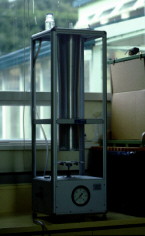
Plate 1 Burkart® potter spray tower
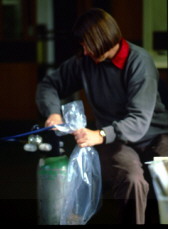
Plate 2 Anoxiating bees with CO2
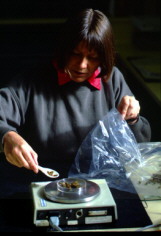
Plate 3 Weighing bees in a Petri dish
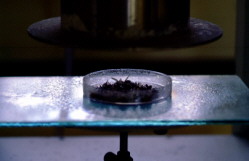
Plate 4 Spraying anethetised bees
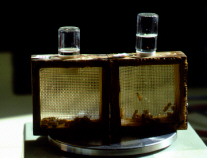
Plate 5 Honeybees in a cage
Ten groups of bees were sprayed with water (2157 litres/ha, S.E. = 100) and ten with Citowett® (0.025%)(2169 litres/ha, S.E. = 61). The recommended rate is 0.02-0.025%. There was no significant (P = 0.33) difference between the survival of bees sprayed with water (mean = 50% , S.E. = 9.4%) and those sprayed with Citowett® (mean = 38%, S.E. = 7.53).
Effect of Citowett® concentration.
Ten groups of bees were sprayed with a variety of concentrations of Citowett® (0 - 0.10%)(2342 litres/ha, S.E. = 56) and placed at 200oC for 24h. Mortality increased with concentrations of 0.031% and higher (Fig. 1). Citowett® did not appear to cause honey bee deaths when used at the recommended rate.

Fig 1 Effect of Citowett® concentration on honey bee mortality. The arrow represents the recommended rate.
Those bees sprayed with water did not appear to be wet. The water remained as discrete droplets on the body of the bees (Plate 6). Those sprayed with surfactants, in high enough concentration to cause mortality, appeared wet (Plate 7)
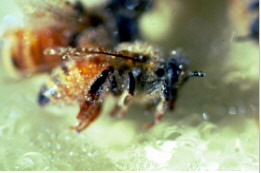
Plate 6 Bees sprayed with water
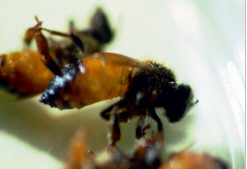
Plate 7 Bees sprayed with a surfactant
Ten groups of bees were sprayed with water (2632 litres/ha, S.E. = 73) and ten with the recommended rate of Pulse® Penetrant (0.2% )(2183 litres/ha, S.E. = 32). Pulse® significantly (P < 0.001) increased honey bee mortality. Only 0.15% of the bees sprayed with water died after 24h compared to 100% of the bees sprayed with Pulse® Penetrant.
Effect of Pulse® Penetrant concentration.
Fourteen groups of bees were sprayed with a variety of concentrations of Pulse® Penetrant (0 - 0.2%, 2056 litres/ha, S.E. = 36). Concentrations of Pulse® Penetrant of 0.02% and higher resulted in high levels of bee mortality (Fig. 2).

Fig. 2 Effect of Pulse® Penetrant concentration (log) on honey bee mortality. The arrow represents the recommended concentration.

Fig. 3. Effect of Boost® Penetrant concentration (log) on honey bee mortality. The arrow represents the recommended rate.

Fig. 4. Effect of Ethokem®concentration (log) on honey bee mortality. The arrow represents the recommended concentration.
| Surfactant | Recommend concentration | Highest concentration tested | Lowest active concentration | Lowest concentration with 100% mortality |
| Citowett® | 0.02 - 0.025% | 0.1% | 0.04% | ------ |
| Pulse® Penetrant | 0.1 - 0.2% | 0.2% | 0.02% | 0.04% |
| Boost® Penetrant | 0.1 - 0.5% | 0.5% | 0.01% | 0.05% |
| Codocide oil® | 0.04 - 0.3% | 0.5% | --------- | ---------- |
| Contact® | 0.025 - 0.1% | 0.1% | --------- | ---------- |
| Raingard® | 0.02 - 0.045% | 0.18% | --------- | --------- |
| Peptoil® | 0.5 - 1.0% | 4.0% | ---------- | ---------- |
| Sunspray® | 0.5 - 1.0% | 4% | ---------- | ---------- |
| Multifilm® | 0.025% | 2% | ---------- | ---------- |
| Uptake® | 0.5% | 0.1% | ---------- | ---------- |
| Ethokem® | 0.2 - 0.5% | 2.0% | 0.5% | ---------- |

Fig. 5. Honey bee mortality (%) when sprayed with different amounts of two concentrations of Boost® Penetrant (0.1%, (recommended rate) and 0.01%, (10% of the recommended rate)
Citowett® reduced the survival of bees at temperatures between 15 and 370oC. The largest difference in survival between the treated and control groups was 230C (Fig. 6).

Fig. 6. Effect of Citowett® on the survival of bees kept for 24h at different temperatures.
The total mortality in the groups of bees sprayed with water was 0.5%. The groups of bees sprayed with Boost ® Penetrant and kept at 20oC (99% mortality, S.E. = 0.7) had significantly (P<0.05) higher mortality than the bees kept at 37oC (95% mortality, S.E.= 1.7).
The cages of bees fed Ethokem® and Boost® had significantly higher (P<0.05) mortality, from 16 h onwards, than the cages of bees fed Pulse®, Citowett® or only sugar syrup (Fig. 7).

Fig. 7. Oral toxicity of Ethokem®, Boost®, Citowett®, at Pulse® to honey bees. The vertical lines are standard error bars.

Fig. 8. Effects of a surfactant (Ethokem®) and starvation on honey bee survival. The vertical lines are standard error bars.
Anoxiating bees to restrict their movement while the surfactants were applied did not appear to have any effect on honeybee survival either through the use of CO2 itself or any combined effect of CO2 and the surfactants. Water by itself was found to not be toxic to bees at the temperatures used for these trials. This was unexpected because growers are often recommended to not spray during the middle of the day as bees may become chilled and die. The observed effects of surfactants suggest that the symptoms reported as chilled bees may have been the result of the surfactant rather than just the water content.
Four (Citowett® Pulse®, Boost® and Ethokem®) of the 11 surfactants tested were toxic to bees when applied. The bees sprayed with the surfactants that were toxic (except for Ethokem®) appeared wet whereas those sprayed with the other products, and the water controls, looked dry with small droplets of water clinging to the hairs on their bodies. This wet appearance is similar to the appearance of those bees described as chilled that are sometimes observed clinging to flowers.
Only three of the surfactants (Pulse®, Boost® and Ethokem®) were toxic when used at the recommended rate. Pulse® caused the highest mortality at the lowest percentage of the recommended rate. It showed activity against honeybees at 10% of the recommended rate. Although Citowett® only caused mortality at concentrations higher than the recommended rate it may cause mortality at lower concentrations under different conditions, e.g. lower temperatures.
Toxicity of Boost® increased when the concentration of the product was increased when the water rate remained constant. Toxicity also increased when the concentration of surfactant remained constant but the amount applied increased.
When Ethokem® and Boost® were added to sugar syrup fed to the bees instead of being applied topically, they both increased mortality indicating that they were toxic when consumed. The same result might also have been achieved if both products were repellent causing the bees to starve to death. However, in a separate trial Ethokem® resulted in a significantly faster death rate than starvation indicating that the increased mortality was due to oral toxicity. Although they were not tested, it is possible that some of the 7 surfactants that did not show contact activity may have shown oral toxicity.
It is not possible to predict from these trials the full implication of the oral toxicity observed. The surfactant made up all the food the bees had access to. If sprayed on flowers they will be exposed to lower concentrations of the surfactants than they were exposed onto in these trials. The use of a surfactant will however increase the probability of the nectar being contaminated. To assess the actual impact of surfactant oral toxicity it would be necessary to carry out field trials. Field trials are however outside the scope of this project.
Temperature appeared to have an affect on the toxicity of surfactants when they are applied topically. Whether this is the case for all surfactants is unknown. It does however suggest that the toxicity of surfactants should be tested at a range of temperatures.
Some insecticidal compounds are reported to be bee safe and are recommended to be used during flowering e.g. Bacillus thuringiensis (Trade names Agree® 50EP and Dipel®). Bacillus thuringiensis is often used because it can be safely used during the flowering season without endangering honey bees. However, it is recommended that a surfactant is added when spraying kiwifruit or brassicas. If the surfactant chosen was one of those showing activity against honey bees then the Bacillus thuringiensis spray would no longer be safe. The same situation would occur for the many fungicides and herbicides that that carry no bee safety warnings but recommend the addition of a surfactants.
The results of this study suggest that surfactants should go through the registration process and carry appropriate warning labels. This by itself may not result eliminate bee deaths. As surfactants are seen as non-toxic, many people applying sprays may not read warning labels on surfactants. Another approach might be to alter the label of the biologically active compound. Where it is recommended that a surfactant is used, unless it specifies a bee safe surfactant, it should include a warning that the surfactant may be hazardous to bees and that the labels should be read carefully.
Whether an approach to the Pesticides Board would be successful is in doubt. According to Warren Hughs of the Pesticides Board 'surfactants do not meet the definition of a pesticide and therefore do not require registration under the Pesticides Act. Consequently, none are registered as it would be outside the Board's jurisdiction to register them' Warren Hughes did however suggest that they may need approval under the Hazardous Substances and Noxious Organisms Act when it becomes Law. He went on to say that the Board would be unlikely to take the step to declare surfactants to be pesticides as the Pesticides Act is to be repealed in the near future.
It is probably worth while considering an education program for spray operators. This could consist of a series of articles in producer journals.
2) Test the oral toxicity of all surfactants
3) Test a range of products, e.g. fungicides, that have formulations that contain surfactants
4) Determine the residual effects of orally toxic surfactants applied to flowers.
Home NZ Bkpg Bee Diseases Organisation Information Contacts
Email to Nick Wallingford, webmaster of the site...